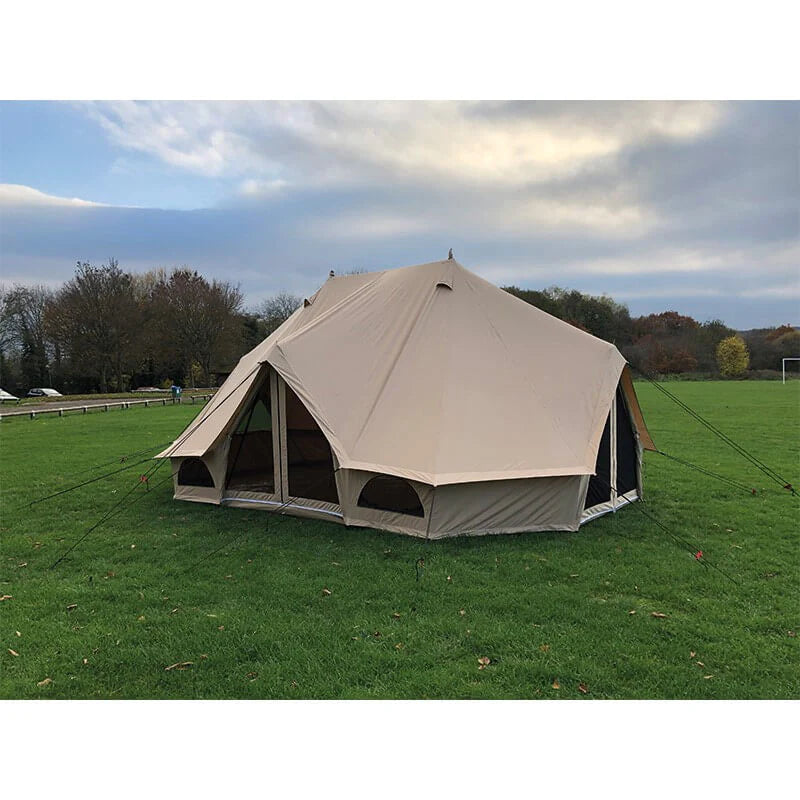How Warm is a Bell Tent?
Ever wondered if a bell tent—or its fancy cousin, the glamping tent—is actually warm or just pretty décor in the cold?
Short answer: yes, they can be surprisingly cosy thanks to canvas, insulation, and heaters.
Keep reading to turn your tent into a snug retreat year-round.
The Innate Warmth of Bell Tents: Design and Material Advantages
Superior Insulation from Natural Fabrics
Cotton Canvas: Thickness and natural fibres trap air for excellent thermal mass and insulation.
Bell tents are typically made from canvas, which is both strong and breathable.
Cotton canvas, in particular, has thick natural fibres that trap warm air effectively.
This creates what’s known as thermal mass, helping to maintain warmth inside the tent.
Even during colder nights, the fabric’s insulating quality makes a noticeable difference.
It keeps warmth in, while still allowing airflow to prevent condensation.

Polycotton Canvas: Good balance of insulation and lighter weight/faster drying.
Polycotton canvas blends cotton with synthetic fibres.
This option strikes a balance between warmth and practicality.
It's lighter, dries faster, and still offers decent insulation for most seasons.
Many glamping tents use this material to offer a comfortable mix of form and function.
Comparison to thinner, synthetic tents (nylon/polyester).
Unlike bell tents, many dome or backpacking tents use thin synthetic fabrics like nylon or polyester.
These materials are easy to pack and set up but aren’t great at holding warmth.
They can quickly feel chilly once the temperature drops.
Bell tents offer superior warmth due to their thicker, breathable canvas.
Heavy-duty PVC Groundsheet: Provides a barrier against cold from the ground.
A quality bell tent usually comes with a heavy-duty PVC groundsheet.
This sheet prevents cold and damp from seeping in from the earth below.
It’s especially useful in the UK’s unpredictable weather.
Paired with rugs or floor mats, it helps retain ground-level warmth very effectively.
Design Features That Enhance Heat Retention
Conical Shape: Promotes efficient warm air circulation.
The classic bell tent shape isn’t just for looks.
Its conical form naturally encourages warm air to rise and circulate efficiently.
This helps avoid cold pockets forming in corners, making the entire space more evenly heated.
Spacious Interior: Larger air volume creates a more stable internal temperature.
Bell tents tend to have high ceilings and generous floor space.
This larger air volume helps maintain a stable internal temperature.
The environment doesn’t heat up or cool down too quickly.
That’s a big plus when camping in areas with fluctuating weather.
Reduced Drafts: Well-fitted doors and groundsheets minimise cold air ingress.
Well-designed bell tents feature snug-fitting doors and zipped-in groundsheets.
These design elements help block out cold drafts.
When paired with good setup technique, the result is a tent that feels far more protected and warm.
Additional air gaps from inner tents or outer flysheets for insulation.
Adding an inner tent or a secondary flysheet creates an insulating air gap.
This small pocket of trapped air can make a big difference in overall warmth.
It's a simple upgrade that greatly boosts comfort in colder weather.
Maximising Warmth: Heating Options and Cold Weather Preparedness
Effective Heating Solutions for Bell Tents
Wood-Burning Stoves: Most effective, requires stove jack, fire-retardant materials, CO alarm.
For serious warmth, a wood-burning stove is hard to beat.
It needs a stove jack and fire-retardant setup but delivers excellent heat.
You’ll also need a carbon monoxide detector and must follow all safety measures.
This setup is very popular with winter glampers and off-grid campers alike.
Electric Heaters: Convenient with EHU, generally lower heat output.
If you're staying at a site with electric hook-up (EHU), a portable electric heater is a handy option.
It’s easy to use and doesn’t require much setup.
However, it may not be as powerful as a stove, especially in large bell tents.
Still, it’s a reliable choice for light winter use.
Propane/Gas Heaters: Portable, but require extreme ventilation due to CO and moisture.
Gas heaters can warm up a tent quickly but come with serious safety caveats.
They produce carbon monoxide and moisture, so proper ventilation is a must.
Always follow manufacturer instructions and never use them while sleeping.
Passive Heating Methods (e.g. hot water bottles, tea light lanterns).
Old-school methods still work.
Hot water bottles, thermal flasks, and even a tea light lantern inside a terracotta pot can make things feel warmer.
These low-tech options are perfect for lightweight or short trips.
They also pose fewer risks if used safely.

Essential Accessories for Bell Tent Warmth
Insulated Inner Tents/Liners: Creates an air gap for extra warmth.
Using an inner tent or thermal liner can make a noticeable difference.
It traps heat inside the living area and reduces heat loss.
Ideal for both winter glamping and frosty festivals.
Thick Ground Coverings: Coir matting, rugs, insulated groundsheets to block ground cold.
Don’t overlook the ground.
Laying down coir matting, wool rugs, or thermal groundsheets blocks cold rising from below.
It adds comfort underfoot and boosts insulation.
High-Quality Sleeping Bags: Rated for expected temperatures.
Even in a well-heated tent, a good sleeping bag is essential.
Choose one rated for lower temperatures than expected—just in case.
Look for mummy-style bags with hoods for maximum heat retention.
External Flysheets/Tarps: Adds an insulating layer and weather protection.
An extra tarp or flysheet over the tent helps shield it from wind and rain.
It also creates a secondary layer that keeps more warmth inside.
This works especially well in heavy rain or snow.
Considerations for All-Season Comfort and Safety
Bell Tents: Versatility Across Seasons
Canvas breathability helps keep tents cool in summer by preventing “oven” effect.
While bell tents shine in winter, they’re also great in summer.
Canvas is breathable and helps release hot air, stopping the tent from turning into an oven.
This makes it more versatile than synthetic tents.
Importance of ventilation (windows, vents, roll-up walls) in warmer conditions.
Most bell tents come with roll-up sides, mesh windows, and air vents.
These features make it easy to adjust ventilation depending on the weather.
They keep things airy in summer and reduce condensation in winter.
With proper setup, bell tents can be comfortable in all seasons.
Whether you’re glamping in the Lake District or winter camping in Scotland, a bell tent can adapt.
All it takes is the right gear, proper insulation, and good airflow.
This flexibility is what makes them so popular for year-round adventures.

Safety First: Critical Reminders for Any Heating Method
Always ensure ample ventilation when using any heater.
No matter how you heat your tent, fresh air must be allowed in.
Lack of ventilation is dangerous, especially with combustion-based heaters.
Use a reliable Carbon Monoxide (CO) Detector.
Never camp without one if you're using a stove or gas heater.
It could literally save your life.
Never leave heating devices unattended, especially while sleeping.
Turn off all heaters before you sleep or step outside the tent.
Fire safety should always come first.
Follow all manufacturer safety guidelines for tents and heating equipment.
Stick to the manual.
Whether it's a stove, heater, or electric setup, always follow the manufacturer’s instructions.
It ensures both safety and long-term use of your gear.
Other content you might like:






Leave a comment